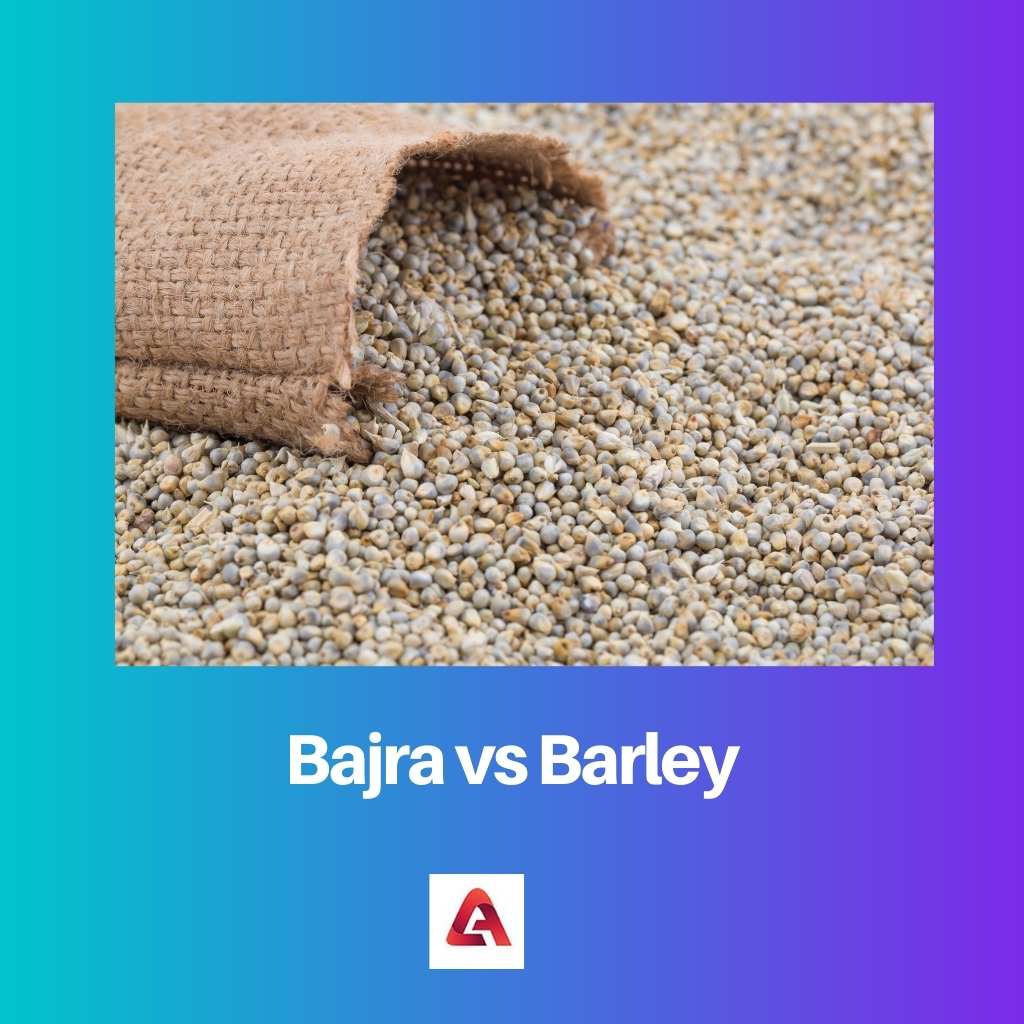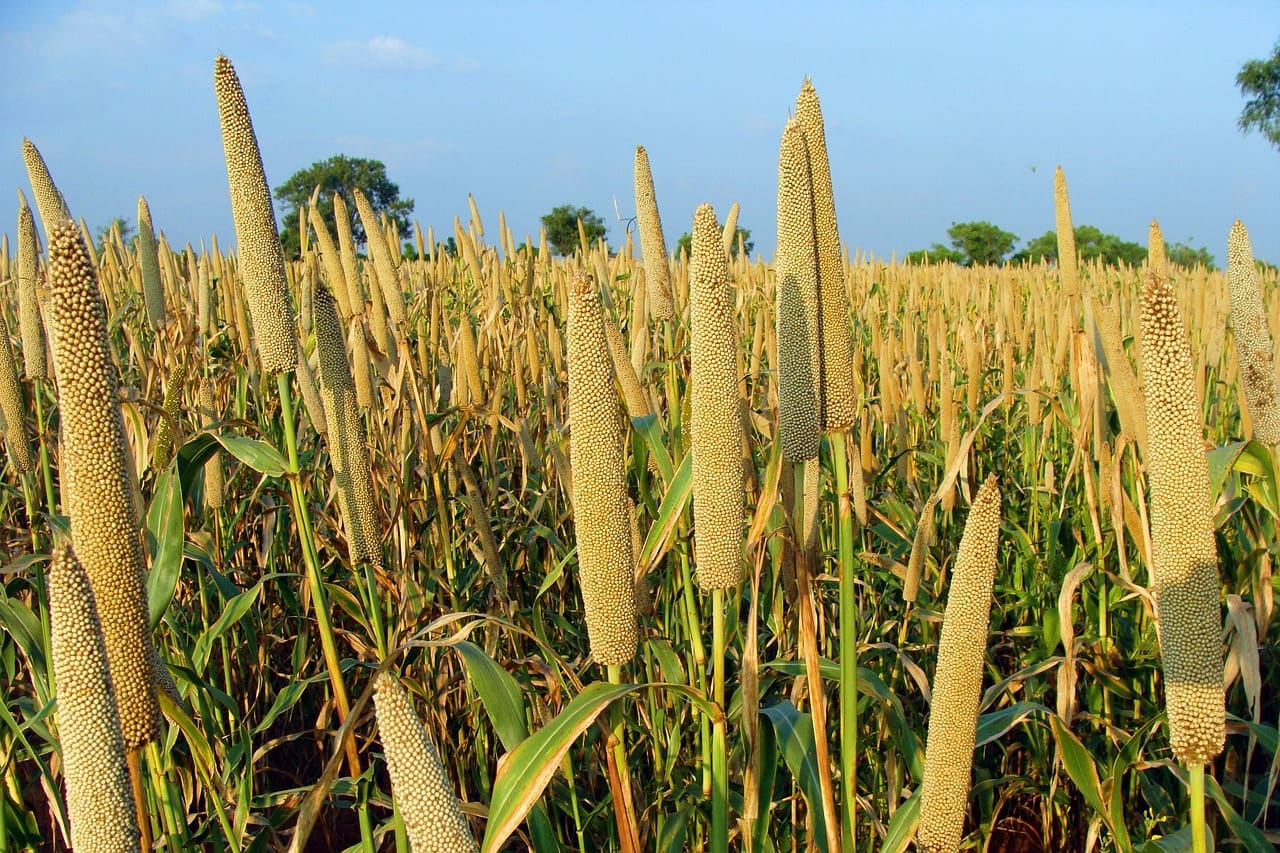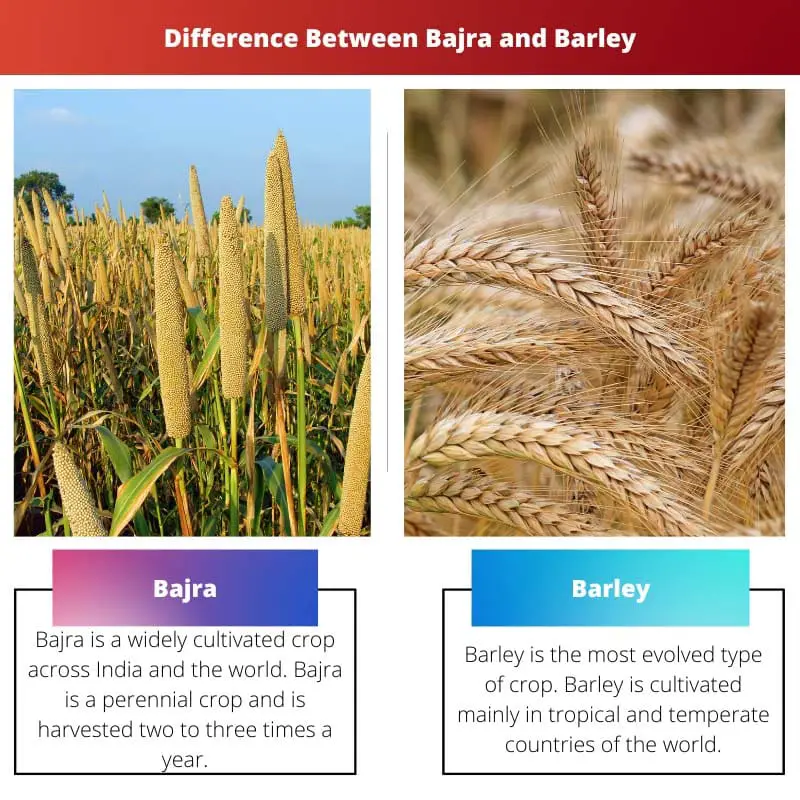Agricultural practices started millions of years ago with lots of edible crops cultivated throughout the year. Bajra and barley are two major crops harvested by the farmers every year.
Mostly spread throughout the temperate areas, bajra and barley are very rich in dietary fibers and carbohydrates.
Key Takeaways
- Bajra, or pearl millet, is a cereal grain with a coarse texture and high protein content, while barley has a chewy texture and high fiber content.
- Bajra is more drought-resistant and suitable for dry, arid regions, whereas barley can be grown in various climates.
- Bajra is gluten-free and an excellent option for those with gluten sensitivities, while barley contains gluten and is unsuitable for those with celiac disease or gluten intolerance.
Bajra vs Barley
The difference between bajra and barley is that bajra is easily cultivated in temperate regions with two to three times harvesting in a year. On the other hand, barley is adaptive to temperate and tropical regions with annual yield. Both of these are high on nutrients and are fibrous too.

Bajra is a widely cultivated crop across India and the world. Bajra is a perennial crop and is harvested two to three times a year.
This type of crop is mainly sown in the temperate regions of the world and India. Also, the germination time needed for the bajra crop is around four to five days.
Barley is the most evolved type of crop. Barley is cultivated mainly in tropical and temperate countries of the world.
Also, barley has a high tendency to be grown in black alluvial soil in the Indian region. Barley is an annual crop and is harvested once a year owing to the weather.
Comparison Table
| Parameters of Comparison | Bajra | Barley |
|---|---|---|
| Energy content | Bajra has a very low energy content. | Barley has a very high energy content of 512 Kilojoule for every 100g of barley |
| Vitamin content | Bajra is limited when talking about vitamin content. Bajra contains a high quantity of calcium and phosphorus. | Barley has a high content of vitamin B composition. |
| Origin | Bajra originated around 2000-2500 BC in the farming industry. | Barely was introduced around 1000 BC in the farming industry. |
| Plant type | Bajra is a monocot shrub type of plant. | Barely belongs to a grass family with short weighted plants. |
| Scientific Nomenclature | Pennisetum glaucum is the scientific name of bajra | Hordeum vulgare is the scientific name of Barley. |
What is Bajra?
In English, bajra is commonly known as Pearl millet. The historic evidence shows that bajra was cultivated in the Indian subcontinent millions of years ago.
However, the recognition of bajra as a major crop started around 2000-2500 BC in the Sahel zone of northern Mali. The grains of bajra are oval and are included as one of the largest grain sizes in millet varieties.
The bajra kernels show a variety of colors ranging from pale yellow to white and grayish to brownish shading.
Also, the plant height shows a wide range of variety ranging from 50 cm to 4 meters. The cultivation of bajra crops is very suitable for the Indian climate as well as soil.
Bajra can also be well cultivated in areas of low fertility, low nitrogen content, scarcity of water, high temperature, and low salinity.
The above qualities make bajra a better option for the areas where harvesting other cereals is a tough job.
Moreover, bajra is rich in many types of protein and dietary fibers. This is why bajra is the major part of Rajasthani and Gujarati cuisines.

What is Barley?
Barley has become one of the major cereal crops mainly cultivated in the regions of temperate climate across the globe. Barley is one of the prominent members of the grass family.
Looking at history, barley was firstly found in the regions of Eurasia around 10,000 years ago.
Barlly is extensively used as animal fodder, a major source of distilled and fermented beer and other beverages.
Due to its nutritional values, barely is also a prominent component of a healthy diet and foods such as ready-to-eat barley bread, stew and soups, and many more food items.
According to the world’s stats of grain production, barley has attained the fourth rank after wheat, rice, and maize. Barley is one of the most evolved cereal crops cultivated throughout the world.
In many temperate areas of the world, barley is cultivated as a summer crop whereas in tropical regions barley is harvested in the winter season.
The germination period of barley is around two to three days. Barley has a high tolerant capacity towards soil salinity. This is the main reason why barley is cultivated more than wheat.

Main Differences Between Bajra and Barley
- Bajra yields about two to three harvesting in a year while barley is an annual crop with once a year yield.
- Bajra has a germination period of four to five days whereas barley has a germination period of two to three days.
- Bajra crops can only be cultivated in temperate regions. Contrarily, barley can be cultivated in tropical as well as temperate regions of the world.
- Bajra does not show tolerance to soil salinity as this may destroy the crop but barley depicts high tolerance to soil salinity and can be cultivated in such areas.
- Bajra shows a high variety in color variation from pale yellow to brownish grains while barley grains show common wheatish color.

References
- https://www.researchgate.net/profile/Sushil-Mahapatra/publication/21344061_Glycaemic_response_to_maize_bajra_and_barley/links/56177ea108ae40a7199abfd1/Glycaemic-response-to-maize-bajra-and-barley.pdf
- https://www.sciencedirect.com/science/article/pii/S0308814600002788
- https://www.cabdirect.org/cabdirect/abstract/20103267806
- https://books.google.com/books?hl=en&lr=&id=ufvdBgAAQBAJ&oi=fnd&pg=PR12&dq=barley+&ots=sA2xEe_AmL&sig=LMvAjL6zJ3Rnhiic2vRJgFUOgt8
